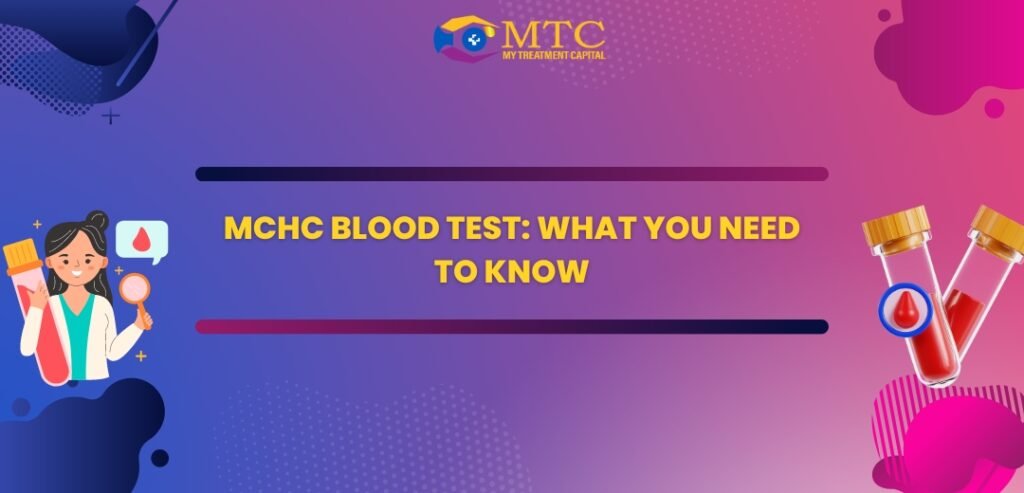Blood tests are an essential tool in modern medicine, providing valuable insights into our health. Among these tests, the Mean Corpuscular Hemoglobin Concentration (MCHC) test plays a crucial role in assessing various blood disorders and conditions. Understanding what MCHC entails, and its significance can empower individuals to take proactive steps toward maintaining their health. Here, we delve into the intricacies of the MCHC blood test, its interpretation, and its clinical relevance.
What is MCHC?
MCHC stands for Mean Corpuscular Hemoglobin Concentration. It is a measure of the average concentration of hemoglobin in a given volume of packed red blood cells (RBCs). Hemoglobin is the protein within red blood cells responsible for carrying oxygen from the lungs to the body’s tissues and returning carbon dioxide from the tissues back to the lungs for exhalation. The MCHC value is expressed as a percentage.
Causes of MCHC
Low MCHC (Hypochromia)
Iron Deficiency Anemia: This is the most common cause of hypochromia. Iron is a crucial component of hemoglobin, and insufficient iron leads to decreased hemoglobin synthesis, resulting in hypochromic red blood cells.
Thalassemia: Thalassemia is a group of genetic disorders characterized by abnormal hemoglobin production. Individuals with thalassemia produce fewer or abnormal hemoglobin molecules, leading to hypochromic red blood cells.
Chronic Diseases: Chronic inflammatory conditions such as rheumatoid arthritis, chronic kidney disease, or inflammatory bowel disease can interfere with red blood cell production or lifespan, resulting in hypochromia.
Sideroblastic Anemia: This rare disorder is characterized by ineffective erythropoiesis due to abnormal iron metabolism within developing red blood cells, leading to the production of hypochromic red blood cells.
Lead Poisoning: Lead interferes with enzymes involved in hemoglobin synthesis, leading to decreased production of hemoglobin and hypochromic red blood cells.
Chronic Blood Loss: Conditions such as gastrointestinal bleeding, heavy menstruation, or certain cancers can lead to chronic blood loss, resulting in iron deficiency anemia and hypochromia.
High MCHC (Hyperchromia)
Hereditary Spherocytosis: This is a genetic disorder characterized by defects in red blood cell membrane proteins, leading to spherical-shaped red blood cells, which can have a higher concentration of hemoglobin and result in hyperchromic red blood cells.
Autoimmune Hemolytic Anemia: In this condition, the body’s immune system mistakenly attacks its own red blood cells, leading to their destruction and the release of hemoglobin into the bloodstream, resulting in hyperchromic red blood cells.
Burn Injuries: Severe burns can lead to dehydration and hemoconcentration, causing an increase in the concentration of red blood cells and hemoglobin, leading to hyperchromia.
Hemoglobinopathies: Certain genetic conditions affecting the structure of hemoglobin, such as sickle cell disease or unstable hemoglobin variants, can result in the production of red blood cells with abnormal hemoglobin concentrations, leading to hyperchromic red blood cells.
Dehydration: Severe dehydration can lead to hemoconcentration, where the concentration of red blood cells and hemoglobin in the blood increases, resulting in hyperchromia.
These are some of the more detailed causes of both low and high MCHC levels. However, it’s important to note that interpreting MCHC levels requires a comprehensive assessment by a healthcare professional, including consideration of other blood parameters and clinical findings.
The MCHC Blood Test: Procedure and Interpretation
To conduct an MCHC blood test, a healthcare professional typically draws a blood sample from a vein in the arm. The sample is then analyzed in a laboratory to measure the concentration of hemoglobin within the red blood cells.
Interpreting MCHC values involves understan-ding their relationship with various blood disorders and conditions:
Normal Range: The normal range for MCHC is typically between 32 and 36 grams per deciliter (g/dL) or between 32% and 36%.
High MCHC Levels (Hyperchromia): Elevated MCHC levels may indicate conditions such as dehydration, hereditary spherocytosis (a genetic disorder affecting red blood cells), or certain types of anemia. In some cases, high MCHC levels may also result from laboratory errors or conditions that cause RBCs to shrink, leading to an increased hemoglobin concentration.
Low MCHC Levels (Hypochromia): Low MCHC levels suggest that the hemoglobin concentration within red blood cells is lower than normal. This can occur due to iron deficiency anemia, thalassemia (a genetic disorder affecting hemoglobin production), chronic diseases, or lead poisoning. Hypochromia indicates decreased oxygen-carrying capacity, which can result in symptoms such as fatigue, weakness, and shortness of breath.
Clinical Significance and Diagnostic Utility
The MCHC blood test serves as a valuable diagnostic tool in the assessment of various blood disorders and conditions, including:
Anemia: MCHC levels are often evaluated alongside other parameters, such as hemoglobin levels and mean corpuscular volume (MCV), to diagnose different types of anemia and determine their underlying causes.
Hemoglobinopathies: Certain inherited conditions affecting hemoglobin production or structure, such as sickle cell disease and thalassemia, can lead to abnormal MCHC levels.
Nutritional Deficiencies: Low MCHC levels may indicate deficiencies in essential nutrients like iron, vitamin B12, or folate, which are vital for red blood cell production and function.
Monitoring Treatment: Monitoring MCHC levels over time can help healthcare providers assess the effectiveness of treatment for underlying conditions, such as anemia or nutritional deficiencies.
Conclusion
The MCHC blood test provides valuable information about the concentration of hemoglobin within red blood cells, offering insights into various blood disorders, nutritional deficiencies, and underlying health conditions. By understanding the significance of MCHC values and their interpretation, individuals can collaborate effectively with healthcare professionals to monitor their health, diagnose potential issues, and implement appropriate interventions when necessary. Regular health screenings and discussions with healthcare providers are essential for maintaining optimal health and well-being.
Frequently Asked Questions:
Q. What does MCHC stand for?
Ans. MCHC stands for Mean Corpuscular Hemoglobin Concentration. It measures the average concentration of hemoglobin in a given volume of packed red blood cells (RBCs).
Q. Why is the MCHC blood test performed?
Ans. The MCHC blood test is performed to assess various blood disorders, including anemia, and to evaluate the concentration of hemoglobin within red blood cells. It helps in diagnosing conditions such as iron deficiency anemia, thalassemia, and certain genetic disorders affecting hemoglobin production.
Q. How is the MCHC blood test conducted?
Ans. A healthcare professional collects a blood sample from a vein, usually in the arm. The sample is then analyzed in a laboratory to measure the concentration of hemoglobin within the red blood cells.
Q. What is the normal range for MCHC levels?
Ans. The normal range for MCHC levels is typically between 32 and 36 grams per deciliter (g/dL) or between 32% and 36%.
Q. What do high MCHC levels indicate?
Ans. High MCHC levels, known as hyperchromia, may indicate conditions such as dehydration, hereditary spherocytosis, certain types of anemia, or laboratory errors.
Q. What do low MCHC levels indicate?
Ans. Low MCHC levels, known as hypothermia, suggest decreased hemoglobin concentration within red blood cells. This can be caused by conditions such as iron deficiency anemia, thalassemia, chronic diseases, or lead poisoning.
Q. Can MCHC levels fluctuate?
Ans. Yes, MCHC levels can fluctuate depending on various factors such as hydration status, nutritional intake, underlying health conditions, and medications. Therefore, it’s essential to interpret MCHC results in conjunction with other blood parameters and clinical findings.
Q. How is MCHC related to other blood parameters?
Ans. MCHC is closely related to other blood parameters such as mean corpuscular volume (MCV) and hemoglobin levels. Together, these parameters provide comprehensive information about the size, shape, and hemoglobin content of red blood cells, aiding in the diagnosis and classification of different types of anemia and blood disorders.
Q. Is the MCHC blood test used for diagnosing specific diseases?
Ans. While the MCHC blood test is a valuable diagnostic tool, it is typically used in conjunction with other blood tests and clinical assessments to diagnose specific diseases, such as anemia, hemoglobinopathies, and nutritional deficiencies.
Q. Are there any risks associated with the MCHC blood test?
Ans. The MCHC blood test is a routine blood test and generally carries minimal risks, such as minor bruising or discomfort at the site of blood collection. However, as with any blood test, there is a slight risk of bleeding, infection, or hematoma formation at the puncture site.



